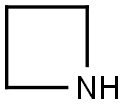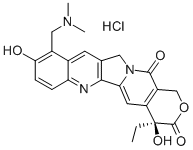Azetidine hydrochloride
Synonym(s):Trimethyleneimine hydrochloride
- CAS NO.:36520-39-5
- Empirical Formula: C3H8ClN
- Molecular Weight: 93.55
- MDL number: MFCD00191762
- EINECS: 627-415-5
- SAFETY DATA SHEET (SDS)
- Update Date: 2024-01-02 14:25:45

What is Azetidine hydrochloride?
Chemical properties
White powder
The Uses of Azetidine hydrochloride
Basic building block for synthesizing azetidines.1,2
The Uses of Azetidine hydrochloride
Azetidine hydrochloride is a building block for azetidine synthesis and a pharmaceutical intermediate.
The Uses of Azetidine hydrochloride
Azetidine hydrochloride is a four-membered ring nitrogen-containing heterocycle. Useful building block in the synthesis of polypeptides and other nitrogen containing compounds with potential biological properties.
General Description
Azetidine derivatives are an essential class of aza-heterocyclic compounds with various biological activities and have been widely used as building blocks in pharmacological research. Although azetidine has the simplest structure, it is only commercially available in small quantities and at a high price. In addition, this compound is hard to synthesize for several reasons, such as cyclization of the four-membered ring, stability of the ring, and low boiling point[1].
References
[1] Jian Sun, Qi Sun, S. Gong. “A Novel Strategy for the Synthesis of Azetidine.” Advanced Materials Research 6 1 (2013): 135–138.
Properties of Azetidine hydrochloride
| Melting point: | >300 °C(lit.) |
| Flash point: | 152 °C |
| storage temp. | Inert atmosphere,2-8°C |
| form | powder to crystal |
| color | White to Almost white |
| Water Solubility | Soluble in water (103.8°C at 760 mmHg). |
| Sensitive | Hygroscopic |
| InChI | InChI=1S/C3H7N.ClH/c1-2-4-3-1;/h4H,1-3H2;1H |
| CAS DataBase Reference | 36520-39-5(CAS DataBase Reference) |
Safety information for Azetidine hydrochloride
| Signal word | Warning |
| Pictogram(s) |
 Exclamation Mark Irritant GHS07 |
| GHS Hazard Statements |
H315:Skin corrosion/irritation H319:Serious eye damage/eye irritation H335:Specific target organ toxicity, single exposure;Respiratory tract irritation |
| Precautionary Statement Codes |
P261:Avoid breathing dust/fume/gas/mist/vapours/spray. P264:Wash hands thoroughly after handling. P264:Wash skin thouroughly after handling. P271:Use only outdoors or in a well-ventilated area. P280:Wear protective gloves/protective clothing/eye protection/face protection. P302+P352:IF ON SKIN: wash with plenty of soap and water. P305+P351+P338:IF IN EYES: Rinse cautiously with water for several minutes. Remove contact lenses, if present and easy to do. Continuerinsing. |
Computed Descriptors for Azetidine hydrochloride
| InChIKey | HGQULGDOROIPJN-UHFFFAOYSA-N |
| SMILES | C1CNC1.Cl |
Azetidine hydrochloride manufacturer
ALS INDIA LIFE SCIENCES
THINQ Pharma CRO Ltd
New Products
(S)-3-Aminobutanenitrile hydrochloride 4-Methylphenylacetic acid N-Boc-D-alaninol N-BOC-D/L-ALANINOL Tert-butyl bis(2-chloroethyl)carbamate 3-Morpholino-1-(4-nitrophenyl)-5,6-dihydropyridin- 2(1H)-one Furan-2,5-Dicarboxylic Acid Tropic acid 1-Bromo-3,5-Di-Tert-Butylbenzene S-2-CHLORO PROPIONIC ACID ETHYL ISOCYANOACETATE 2-Bromo-1,3-Bis(Dimethylamino)Trimethinium Hexafluorophosphate 4-IODO BENZOIC ACID 3-NITRO-2-METHYL ANILINE 1-(2,4-DICHLOROPHENYL) ETHANAMINE (2-Hydroxyphenyl)acetonitrile 4-Bromopyrazole 2-(Cyanocyclohexyl)acetic acid 4-methoxy-3,5-dinitropyridine 1-(4-(aminomethyl)benzyl)urea hydrochloride 2-aminopropyl benzoate hydrochloride diethyl 2-(2-((tertbutoxycarbonyl)amino) ethyl)malonate tert-butyl 4- (ureidomethyl)benzylcarbamate Ethyl-2-chloro((4-methoxyphenyl)hydrazono)acetateRelated products of tetrahydrofuran






![3-[(4-Chlorophenyl)thio]-1-(diphenylmethyl)azetidine](https://img.chemicalbook.in/CAS/GIF/132924-59-5.gif)

You may like
-
 36520-39-5 Azetidine hydrochloride(1:1) 98%View Details
36520-39-5 Azetidine hydrochloride(1:1) 98%View Details
36520-39-5 -
 36520-39-5 Azetidine hydrochloride(1:1) 99%View Details
36520-39-5 Azetidine hydrochloride(1:1) 99%View Details
36520-39-5 -
 Azetidine Hydrochloride CAS 36520-39-5View Details
Azetidine Hydrochloride CAS 36520-39-5View Details
36520-39-5 -
 Azetidine hydrochloride, 97% CAS 36520-39-5View Details
Azetidine hydrochloride, 97% CAS 36520-39-5View Details
36520-39-5 -
 Azetidine CAS 36520-39-5View Details
Azetidine CAS 36520-39-5View Details
36520-39-5 -
 Azetidine hydrochloride CAS 36520-39-5View Details
Azetidine hydrochloride CAS 36520-39-5View Details
36520-39-5 -
 14714-50-2 (2-Hydroxyphenyl)acetonitrile 98+View Details
14714-50-2 (2-Hydroxyphenyl)acetonitrile 98+View Details
14714-50-2 -
 118753-70-1 98+View Details
118753-70-1 98+View Details
118753-70-1